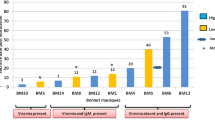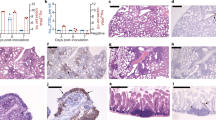Abstract
THE intranasal infection of vervet monkeys (Cercopithecus aethiops) with SV-5 virus, which belongs to the parainfluenza 2 group1, has been reported to result in a disease pattern usually observed in naturally occurring parainfluenza virus infections of man2,3. It was suggested, therefore, that this experimental model was potentially useful for the evaluation of appropriate antiviral drugs and also for investigation of the pathology and pathogenesis of acute respiratory viral disease.
This is a preview of subscription content, access via your institution
Access options
Subscribe to this journal
Receive 51 print issues and online access
$199.00 per year
only $3.90 per issue
Buy this article
- Purchase on Springer Link
- Instant access to full article PDF
Prices may be subject to local taxes which are calculated during checkout
Similar content being viewed by others
References
Andrewes, C., Viruses of Vertebrates, 130 (Baillière, Tindall and Cox, London, 1964).
Larin, N. M., Herbst-Laier, R. H., and Heath, R. B., Proc. Third Intern. Congr. Chemother., Stuttgart, 1963, 775 (Georg Thieme Verlag, Stuttgart, 1964).
Heath, R. B., Islah, El F., Stark, J. E., Herbst-Laier, R. H., and Larin, N. M., Brit. J. Exp. Pathol., 47, 1, 93 (1966).
Author information
Authors and Affiliations
Rights and permissions
About this article
Cite this article
LARIN, N., HERBST-LAIER, R., COPPING, M. et al. Controlled Investigations in Baboons (Papio cynocephalus) on Transmission of SV-5 Virus by Contact. Nature 213, 827–828 (1967). https://doi.org/10.1038/213827b0
Issue Date:
DOI: https://doi.org/10.1038/213827b0
This article is cited by
-
Organ cultures in evaluation of antiviral drugs
Archiv f�r die gesamte Virusforschung (1970)
Comments
By submitting a comment you agree to abide by our Terms and Community Guidelines. If you find something abusive or that does not comply with our terms or guidelines please flag it as inappropriate.



